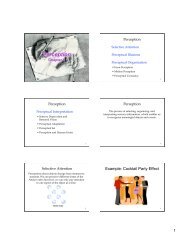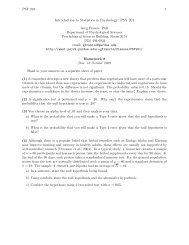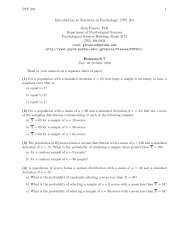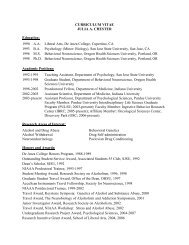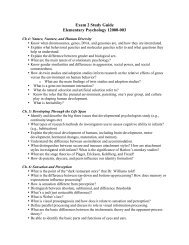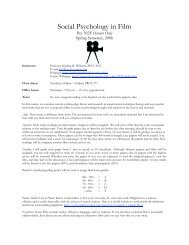Maxims or Myths of Beauty? A Meta-Analytic and Theoretical Review
Maxims or Myths of Beauty? A Meta-Analytic and Theoretical Review
Maxims or Myths of Beauty? A Meta-Analytic and Theoretical Review
Create successful ePaper yourself
Turn your PDF publications into a flip-book with our unique Google optimized e-Paper software.
which participants make inf<strong>or</strong>med judgments <strong>of</strong> attractive <strong>and</strong><br />
unattractive targets following actual interaction <strong>or</strong> on the basis <strong>of</strong><br />
role relationships (e.g., real teachers <strong>and</strong> their students), thereby<br />
extending results from the stranger-attribution literature to m<strong>or</strong>e<br />
ecologically valid situations.<br />
Stereotypes <strong>and</strong> differential expectations about attractive <strong>and</strong><br />
unattractive people also cause differential treatment <strong>of</strong> them ac-<br />
c<strong>or</strong>ding to social the<strong>or</strong>y. In our third set <strong>of</strong> meta-analyses (treat-<br />
ment), we examine whether attractive <strong>and</strong> unattractive people are<br />
actually treated differently, especially by those who know them.<br />
Finally, the the<strong>or</strong>ies hold that attractive <strong>and</strong> unattractive targets<br />
come to behave differently <strong>and</strong> develop different traits as a func-<br />
tion <strong>of</strong> differential judgment <strong>and</strong> treatment. Our fourth set <strong>of</strong><br />
meta-analyses (behavi<strong>or</strong>/traits) reveals whether <strong>or</strong> not attractive<br />
<strong>and</strong> unattractive people behave differently <strong>and</strong> possess different<br />
traits.<br />
Confirmation <strong>of</strong> these c<strong>or</strong>e assumptions is necessary f<strong>or</strong> social<br />
the<strong>or</strong>ies to unambiguously explain attractiveness effects. However,<br />
several ancillary premises regarding age <strong>and</strong> gender differences<br />
would provide further supp<strong>or</strong>t f<strong>or</strong> the the<strong>or</strong>ies. First, age should<br />
influence the reliability <strong>of</strong> attractiveness ratings because, relative<br />
to younger judges, older judges have internalized societal, stan-<br />
dards <strong>of</strong> attractiveness. Second, because many interactions be-<br />
tween adults <strong>and</strong> children involve socialization in which adults<br />
deliberately encourage some behavi<strong>or</strong>s <strong>and</strong> discourage others,<br />
attractiveness should have m<strong>or</strong>e opp<strong>or</strong>tunities to influence the<br />
judgments <strong>and</strong> treatment <strong>of</strong> child than adult targets. Thus, these<br />
perspectives should predict that attractive <strong>and</strong> unattractive children<br />
will receive m<strong>or</strong>e differential treatment <strong>and</strong> judgment than will<br />
adults. Third, the accounts should predict age differences in tar-<br />
gets' behavi<strong>or</strong>s <strong>and</strong> traits as a result <strong>of</strong> cumulative socialization. If<br />
behavi<strong>or</strong>al differences result from differential treatment based on<br />
attractiveness, as assumed by the the<strong>or</strong>ies, behavi<strong>or</strong>al differences<br />
as a function <strong>of</strong> attractiveness should not be evident very early in<br />
life yet, as children are exposed to m<strong>or</strong>e socialization eff<strong>or</strong>t <strong>and</strong> as<br />
a result <strong>of</strong> cumulative differential judgment <strong>and</strong> treatment, should<br />
become increasingly present with age. Analyses examining attrac-<br />
tiveness effects f<strong>or</strong> both children <strong>and</strong> adults are required to eval-<br />
uate these age-related ancillary premises <strong>of</strong> social the<strong>or</strong>y <strong>and</strong> are<br />
perf<strong>or</strong>med below.<br />
In addition to predictions about age differences in the imp<strong>or</strong>-<br />
tance <strong>of</strong> attractiveness, socialization <strong>and</strong> social expectancy the<strong>or</strong>ies<br />
make ancillary predictions about gender differences in the imp<strong>or</strong>-<br />
tance <strong>of</strong> attractiveness. Because human culture values attractive-<br />
ness m<strong>or</strong>e in females than in males, agreement about the attrac-<br />
tiveness <strong>of</strong> females should be greater than agreement about males,<br />
<strong>and</strong> females should experience m<strong>or</strong>e differential judgment <strong>and</strong><br />
treatment based on attractiveness than males (Hatfield & Sprecher,<br />
1986; L. A. Jackson, 1992; Zebrowitz, 1997). M<strong>or</strong>eover, the<br />
effects <strong>of</strong> attractiveness on behavi<strong>or</strong>s, traits, <strong>and</strong> self-views should<br />
be larger f<strong>or</strong> females than males because females receive m<strong>or</strong>e<br />
differential judgment <strong>and</strong> treatment as a function <strong>of</strong> their attrac-<br />
tiveness. To evaluate these predictions, we examine gender differ-<br />
ences in all our analyses.<br />
Fitness-Related Evolutionary The<strong>or</strong>ies<br />
Fitness-related evolutionary the<strong>or</strong>ies (human mate selection,<br />
good genes, differential parental solicitude) posit that m<strong>or</strong>pholog-<br />
MAXIMS OR MYTHS OF BEAUTY 393<br />
ical characteristics such as attractiveness are honest indicat<strong>or</strong>s <strong>of</strong><br />
fitness, health, quality, <strong>and</strong> reproductive value, <strong>and</strong>, theref<strong>or</strong>e, that<br />
attractiveness is imp<strong>or</strong>tant in human interactions (Barber, 1995;<br />
Buss & Schmitt, 1993; Daly & Wilson, 1995; Gangestad & Th<strong>or</strong>n-<br />
hill, 1997; Symons, 1979; Th<strong>or</strong>nhill & Gangestad, 1993). All three<br />
perspectives agree about the necessity <strong>of</strong> one a pri<strong>or</strong>i condition:<br />
Because humans have evolved universal st<strong>and</strong>ards <strong>of</strong> attractive-<br />
ness based on clues to health <strong>and</strong> reproductive fitness, perceivers<br />
both within <strong>and</strong> across cultures should consistently detect <strong>and</strong><br />
recognize attractiveness. Other predictions about attractiveness<br />
differ across mechanisms <strong>and</strong> are described below.<br />
Mate Selection<br />
Mate selection is the most commonly invoked evolutionary<br />
mechanism <strong>of</strong>fered to explain attractiveness effects in both hu-<br />
mans <strong>and</strong> animals. A central tenant <strong>of</strong> mate-selection the<strong>or</strong>y is that<br />
attractiveness is differentially imp<strong>or</strong>tant f<strong>or</strong> the two sexes (Anders-<br />
son, 1994; Buss, 1998, 1999; Buss & Barnes, 1986; Buss &<br />
Schmitt, 1993; G. F. Miller, 1998; Symons, 1979). With most<br />
nonhuman species, it is the male f<strong>or</strong> whom attractiveness <strong>and</strong><br />
"showiness" is m<strong>or</strong>e imp<strong>or</strong>tant. Peacock feathers, turkey snoods,<br />
<strong>and</strong> col<strong>or</strong>ful cichlid bellies in males are all assumed to have<br />
evolved as sexual enticements f<strong>or</strong> females. However, with humans,<br />
it is almost always the female f<strong>or</strong> whom attractiveness <strong>and</strong> show-<br />
iness is m<strong>or</strong>e imp<strong>or</strong>tant. Thus, acc<strong>or</strong>ding to human mate-selection<br />
the<strong>or</strong>y, men seek attractive women because attractiveness signals<br />
youth <strong>and</strong> reproductive fitness (Buss, 1998, 1999; Th<strong>or</strong>nhill,<br />
1998). In contrast, women seek men with resources, rather than<br />
attractiveness, because such men are able to provide f<strong>or</strong> <strong>of</strong>fspring<br />
(see, e.g., Buss, 1998). Because this review is concerned with how<br />
attractiveness affects human development <strong>and</strong> interaction, our<br />
discussion <strong>of</strong> mate-selection the<strong>or</strong>y focuses on humans (see, e.g.,<br />
Buss, 1999).<br />
In humans, because attractiveness is especially imp<strong>or</strong>tant as an<br />
indicat<strong>or</strong> <strong>of</strong> reproductive fitness in women, the reliability <strong>of</strong> at-<br />
tractiveness ratings should be higher when judging females than<br />
when judging males, especially as evaluated by male perceivers<br />
(L. A. Jackson, 1992). This prediction is examined by our reliabil-<br />
ity analyses.<br />
Mate-selection research <strong>of</strong>ten focuses its predictions on pref-<br />
erences rather than behavi<strong>or</strong>s (see, e.g., Buss, 1999). However,<br />
because "mate choice is the behavi<strong>or</strong>al outcome <strong>of</strong> mate pref-<br />
erences" (G. F. Miller, 1998, p. 92), there should be some<br />
c<strong>or</strong>respondence between preferences <strong>and</strong> behavi<strong>or</strong>. Theref<strong>or</strong>e,<br />
because men prefer <strong>and</strong> seek attractive women, men should also<br />
judge <strong>and</strong> treat them m<strong>or</strong>e positively. Because women fav<strong>or</strong><br />
men with resources m<strong>or</strong>e than merely attractive men, attrac-<br />
tiveness should be m<strong>or</strong>e imp<strong>or</strong>tant in how men judge <strong>and</strong> treat<br />
women than in how women judge <strong>and</strong> treat men (Buss &<br />
Barnes, 1986; Buss & Schmitt, 1993; L. A. Jackson, 1992). We<br />
evaluate these predictions in our analyses <strong>of</strong> judgment <strong>and</strong><br />
treatment.<br />
In contrast to the gender difference predictions f<strong>or</strong> reliability,<br />
judgments, <strong>and</strong> treatment, mate-selection the<strong>or</strong>y predicts no gen-<br />
der differences in the imp<strong>or</strong>tance <strong>of</strong> attractiveness f<strong>or</strong> most target


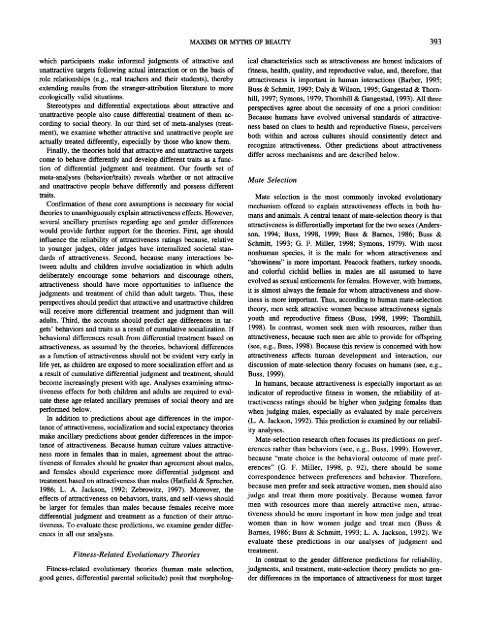
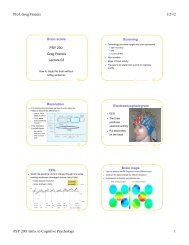

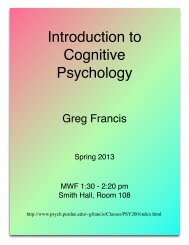
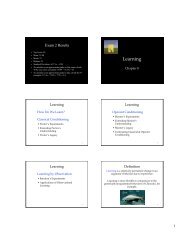
![Exam 4 Study Guide[1]](https://img.yumpu.com/45196739/1/190x245/exam-4-study-guide1.jpg?quality=85)
